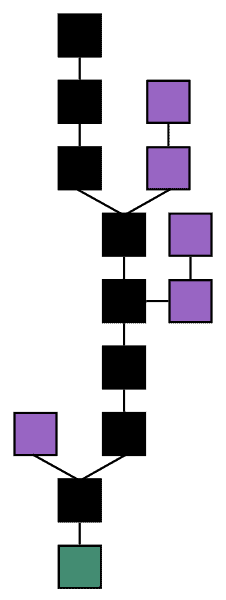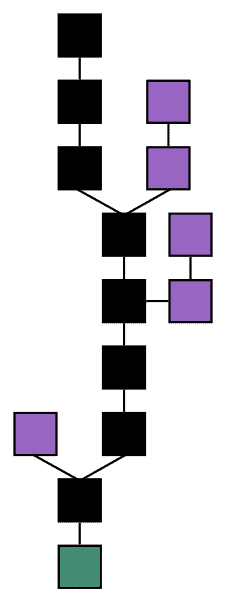
In writing for this blog, I am accustomed to rapid changes from one technological area to another, such as from DNA origami to de novo protein design to scanning probe microscopy to molecular machinery based on mechanically interlocked molecular architectures. The DNA and protein work overlaps with biotechnology, and we have always seen all these molecular topics interlinked with computation, and with increasing frequency recently, with artificial intelligence. These relationships go back to Foresight Institute’s Founding Vision and Eric Drexler’s 1986 book Engines of Creation. But a year ago Foresight’s events and salons began to include concepts new to me, like Bitcoin, cryptocurrencies, and blockchains. The Great Debates of Our Time (November 19, 2016) included a panel (video) discussing “Blockchain, Alternative Societies, Universal Basic Income”; Building Better Futures on Blockchains (May 11, 2017); The Next Frontier: Blockchain meets Object Capabilities (July 3, 2017). In addition Foresight’s 2017 Vision Weekend included a keynote panel “Blockchains – Master Key To Unlock The Future?” on how to build better base realities block by block: Beyond crypto, ICO hype & hope, decentralized governance. Looking for a place to begin to understand what this is all about, I found the following a very useful introduction: “The Blockchain Economy: A beginner’s guide to institutional cryptoeconomics“:
Chris Berg, Sinclair Davidson and Jason Potts are from the RMIT Blockchain Innovation Hub, the world’s first social science research centre into the economics, politics, sociology, and law of blockchain technology.
The blockchain is a digital, decentralised, distributed ledger.
Most explanations for the importance of the blockchain start with Bitcoin and the history of money. But money is just the first use case of the blockchain. And it is unlikely to be the most important.
It might seem strange that a ledger—a dull and practical document associated mainly with accounting—would be described as a revolutionary technology. But the blockchain matters because ledgers matter.
Ledgers all the way down
Ledgers are everywhere. Ledgers do more than just record accounting transactions. A ledger consists simply of data structured by rules. Any time we need a consensus about facts, we use a ledger. Ledgers record the facts underpinning the modern economy. …
At their most fundamental level, ledgers map economic and social relationships.
Agreement about the facts and when they change—that is, a consensus about what is in the ledger, and a trust that the ledger is accurate—is one of the fundamental bases of market capitalism. …
After describing the function and evolution of ledgers, the article explains how the blockchain solves the principal shortcoming of ledgers:
… But a database still relies on trust; a digitised ledger is only as reliable as the organisation that maintains it (and the individuals they employ). It is this problem that the blockchain solves. The blockchain is a distributed ledgers that does not rely on a trusted central authority to maintain and validate the ledger. …
The above conclusion leads into exploring the place of the blockchain among the economic institutions of capitalism, based upon the realization that relative transaction costs determine how ledgers are maintained, and how firms and governments have assumed this function. But now the advent of cryptographically secure ledgers that do not need to be maintained by a trusted authority—a firm or a government— has opened the possibility that “Ledgers of identity, permission, privilege and entitlement can be maintained and enforced without the need for government backing.” this insight opens the field of institutional cryptoeconomics, the study of the institutional consequences of cryptographically secure and trustless ledgers.
After concluding that we can’t yet predict how the blockchain will affect the economy, but we can expect a substantial amount of disruption, the article emphasizes the role of smart contracts, and the distinction between complete and incomplete smart contracts. As smart contracts become more complete, the roles of firms and governments will be lessened. They conclude:
… The blockchain and associated technological changes will massively disrupt current economic conditions. The industrial revolution ushered in a world where business models were predicated on hierarchy and financial capitalism. The blockchain revolution will see an economy dominated by human capitalism and greater individual autonomy.
How that unfolds is unclear at present. Entrepreneurs and innovators will resolve uncertainty, as always, through a process of trial and error. No doubt great fortunes will be made and lost before we know exactly how this disruption will unfold. …
The recent rise in the value of BitCoin, whether a bubble or not, has stimulated great interest in the blockchain, and a recent opinion piece in the New York Times places it in the context of falling confidence in institutions and governments. From “The Bitcoin Boom: In Code We Trust” by Tim Wu, Dec. 18, 2017:
… Yet as Bitcoin continues to grow, there’s reason to think something deeper and more important is going on. Bitcoin’s rise may reflect, for better or worse, a monumental transfer of social trust: away from human institutions backed by government and to systems reliant on well-tested computer code. It is a trend that transcends finance: In our fear of human error, we are putting an increasingly deep faith in technology. …
Although it is too early to foresee what the effects of blockchains will be, it seems already clear that the blockchain is closely linked with long-term Foresight interests in computer security and managing the risks of powerful emerging technologies (see for example Cyber, Nano, and AGI Risks: Decentralized Approaches to Reducing Risks” by Christine Peterson, Mark S. Miller and Allison Duettmann.)
—James Lewis, PhD
Discuss these news stories on Foresight’s Facebook page or on our Facebook group.
